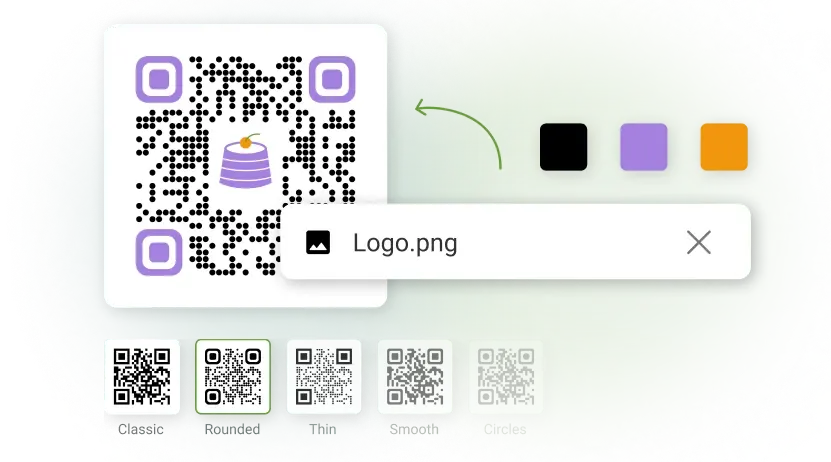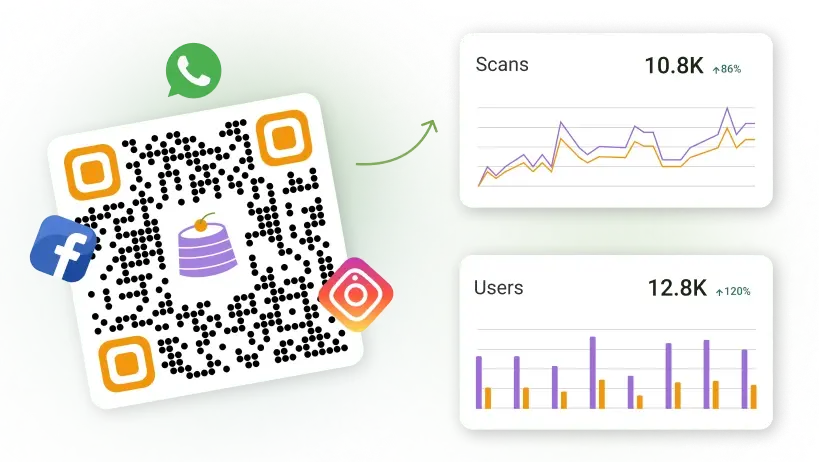QR Codes have become the invisible bridge between our physical and digital worlds. What started as an industrial tracking solution in a Japanese automotive factory has transformed into an essential tool that business owners, professionals, and everyday users rely on daily.
From streamlining manufacturing processes to enabling contactless restaurant menus and digital business cards, QR Codes have forever changed how we share information and connect.
Understanding how QR Code technology evolved helps anyone use it more effectively, whether you’re running a small business, managing professional relationships, or simply looking for convenient ways to share information in your personal life.
Table of contents
- The invention of QR Codes (1990s)
- QR Codes meet smartphone technology (2000s-2010s)
- The smartphone integration era (2010s)
- The COVID-19 catalyst: QR Codes go mainstream (2020-2021)
- How QR Codes are used today
- The future of QR Codes
- Ready to create your own QR Code?
The invention of QR Codes (1990s)
In 1992, Denso Wave (a Toyota subsidiary) faced an efficiency crisis. Workers were scanning up to 1,000 barcodes daily, but traditional barcodes could only store 20 alphanumeric characters and didn’t support Japanese Kanji characters.
Masahiro Hara, an engineer at Denso, led a two-person team to develop a better solution: the Quick Response Code, also known as the QR Code.
Hara’s breakthrough came during a lunchtime game of Go. The black and white stones on the grid inspired him to create a two-dimensional (2D) pattern that could store far more information than one-dimensional barcodes.
The challenge was making these codes instantly recognizable to scanners. After analyzing printed materials worldwide, the team found it: a square pattern with a unique ratio of black and white (1:1:3:1:1). These squares, placed in three corners of the code, became the “position detection patterns” or “finder patterns.” They let scanners instantly recognize a QR Code, even when you’re looking at it from an angle or part of it is covered up.
The final innovation happened in 1994. The completed QR Code could store over 4,000 alphanumeric characters, over 200 times more than barcodes. It could be scanned from any angle and remained functional even when 30% damaged.
Despite these advantages, QR Codes remained confined to automotive manufacturing because they required expensive, specialized scanners. Consumer adoption wouldn’t come until smartphone cameras could read them decades later.
The technology that would eventually change how we interact with the physical world had been quietly sitting on factory floors, waiting for the right conditions to emerge.
QR Codes meet smartphone technology (2000s-2010s)
Fast forward to the early 2000s. Camera phones began to appear, and in 2001, Japanese electronics manufacturer Sharp began producing phones that could scan QR Codes.
Japan, with its mobile-first culture, quickly adopted this trend. By the mid-2000s, QR Codes had begun to appear on consumer products across the country. People could view product information, visit websites, and even make mobile payments just by pointing their phone cameras at a square pattern.
Denso Wave made a decision that ensured global adoption: they retained QR Code patents but waived all royalty fees.
This meant:
- Anyone could create and use QR Codes without licensing fees
- Developers could build scanning applications freely
- Businesses could implement the technology without permission
- The standard became universally accessible
Outside Japan, though, QR Code adoption was modest. Third-party QR Code scanner apps began appearing in app stores, but having to download a separate application to scan QR Codes? That felt like too much work for most people.
In western markets, where mobile payment infrastructure wasn’t as developed and QR Codes weren’t part of the culture yet, they remained more of a curiosity than a necessity.
Free QR Code generator websites made creating QR Codes simple enough. Early adopters started experimenting with them for business cards, event invitations, and marketing materials. However, widespread consumer adoption was still years away.
The smartphone integration era (2010s)
In June 2017, Apple’s iOS 11 had a native QR Code scanning feature directly in the iPhone camera app, eliminating the need for separate scanner applications. When iOS 11 launched, millions of iPhone users gained instant QR Code scanning capability.
Google introduced similar functionality with Android 8.0 through Google Lens integration and further enhanced it with Android 9.0. With both major mobile operating systems supporting native QR Code scanning, the technology became universally accessible.
This integration removed the primary barrier to QR Code adoption. Users no longer needed to download third-party apps, making QR Codes practical for mainstream use on product packaging, event tickets, and marketing materials.
QR Code payment system in Asia
While Western markets primarily used QR Codes for information sharing, Asian markets developed comprehensive payment ecosystems. Chinese super apps like Alipay and WeChat integrated QR Codes for payments, transportation, and services.
By 2016, mobile payments in China reached $5.5 trillion, with QR Codes processing the majority of transactions, becoming a use case the original inventors hadn’t anticipated.
By the late 2010s, QR Code payments became standard across multiple markets:
- India: Unified Payments Interface (UPI)
- Indonesia: Quick Response Code Indonesian Standard (QRIS)
- Singapore: Singapore Quick Response (SGQR)
- China: Alipay and WeChat Pay
These systems established QR Codes as essential financial infrastructure before the pandemic accelerated global adoption.
The COVID-19 catalyst: QR Codes go mainstream (2020-2021)
The COVID-19 pandemic changed how people interacted with physical spaces. Suddenly, contactless interactions weren’t just convenient; they were essential for health and safety.
Industries adapted quickly:
- Restaurants and hospitality: Diners could scan QR Codes to view menus on their phones instead of handling physical copies. Some places have gone entirely digital, printing QR Codes directly on tables.
- Retail: Shoppers could access detailed product information, compare prices, and make purchases without touching shared surfaces or asking staff for help.
- Healthcare and government: Many governments rolled out QR Codes for COVID-19 contact tracing. Vaccination cards featured QR Codes for verification.
- Events and entertainment: Tickets became QR Codes on smartphones. Event check-ins moved from physical tickets to quick scans. Capacity tracking relied on QR Code systems.
- Personal events: Even personal gatherings adopted the technology. Wedding invitations included QR Codes for RSVP and gift registry access. Birthday parties used them for photo sharing and guest information.
The technology that once seemed complicated became essential. People who had never used QR Codes learned because they needed to. With its widespread adoption, many businesses understood the many benefits behind this technology and continued to use QR Codes after pandemic restrictions ended.
How QR Codes are used today
QR Codes today serve a broad range of applications:
| Category | Users | Key applications |
| Food & hospitality | Restaurants, cafes, bars | Digital menus, loyalty programs, table ordering, feedback collection, event promotion |
| Retail businesses | Shops, bookstores, stores | Product catalogs, inventory tracking, author information, customer reviews, promotional offers |
| Professional services | Freelancers, consultants, contractors | Digital business cards, portfolio galleries, appointment scheduling, service pricing, certifications |
| Personal use | Individuals, families | Event invitations with RSVPs, Wi-Fi password sharing, social media consolidation, home inventory systems |
| Public services | Museums, transportation, government | Audio tours, parking payments, public transit tickets, contact tracing, facility information |
| Supply chain | Manufacturers, distributors | Package tracking, product manuals, assembly instructions, warranty information |
Small businesses can now offer the same digital convenience as larger companies, without requiring technical expertise or large budgets, with QR Codes. Additionally, these codes are also adaptable to individual needs and creativity.
Why QR Codes work for everyone
Several factors contribute to the universal appeal and adoption of QR Codes. Here are the main reasons:
- No technical expertise required: You can scan a QR Code by just pointing your camera at it. The technology has become that intuitive.
- Free or less expensive to implement: Countless free QR Code generators exist online. Creating a functional QR Code costs nothing beyond a few minutes of your time.
- Instant updates without reprinting: Changed your website? Updated your hours? Modified your menu? Your dynamic QR Code stays the same while what it points to updates automatically.
- Professional appearance on any budget: Small businesses can look as polished as much larger companies. A well-designed QR Code on a business card or flyer looks modern and tech-savvy.
- Trackable engagement: For those who want it, many QR Code services offer analytics. You can see how many scans, when they happened, and from where, all without requiring a complex technical setup.
The future of QR Codes
QR Code technology continues to evolve with various emerging trends.
- AR QR Codes: The integration of QR Codes and AR is opening up possibilities. Users can now see how furniture would look in their home, explore product features through 3D demonstrations, or access interactive instruction manuals. This technology pairing is creating new possibilities for product interaction and information delivery, and 92% business leaders anticipate AR QR Codes to be more widely adopted over the next few years.
- Enhanced accessibility: Development continues on QR Codes with better support for people with visual impairments. We’re talking audio cues, tactile indicators, and better integration with assistive technologies.
- Digital identity and verification: QR Codes are increasingly used for secure identity verification, digital wallets, and authentication. Boarding passes, vaccine certificates, secure building access. The list keeps growing.
Project Sunrise 2027
Traditional barcodes will likely retire soon, leading to wider QR Code adoption. In 2018, GS1 (the global barcode standards organization) approved the GS1 Digital Link framework, which allows traditional product identification codes to be embedded directly into web URLs.
In 2021, GS1 announced “Project Sunrise 2027.” The plan? Completely phase out 1D barcodes at point-of-sale systems by 2027, replacing them with 2D barcodes (mainly QR Codes).
Twenty-one industry champions of the world’s biggest retail and manufacturing companies (Alibaba.com, Carrefour, and brand owners like Procter and Gamble) are calling for the global adoption of QR Codes with the GS1 standard.
Why the change? A GS1 survey found that consumers were 79% more likely to buy products with QR Codes that led to additional information, such as nutrition facts, allergen details, sourcing information, and recall alerts.
This means that within a few years, every product you buy at the supermarket will likely have a QR Code instead of a traditional barcode. And it’ll tell you not just the price, but the product’s entire story.
Ready to create your own QR Code?
What began 30 years ago on Japanese factory floors as a solution for scanning automotive parts is now used by millions of businesses and individuals worldwide. The same technology that solved manufacturing problems can simplify how you share information.
Whether you’re managing events, building a professional network, running a restaurant, or looking for easier ways to share information, QR Codes are a must-have in your toolkit.







